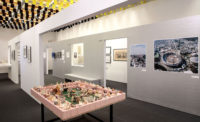With twin political and economic crises in Brazil right now, it is hardly the best time to be hosting this summer’s Olympic Games.
But in Rio de Janeiro, officials are quietly pleased that their preparations mean this stunningly located beach-side metropolis will be ready on time for the opening ceremony August 5 regardless of the problems—which include the impeachment trial of President Dilma Rousseff—occupying the rest of the country.
At the main AECOM-planned Olympic Park, a somewhat barren concrete expanse deep in the western reaches of the Barra da Tijuca neighborhood, the final touches are being made to the three interlocking indoor “Carioca” arenas a full three months before the Games start. Work is also winding down at the Deodoro site, whose elegant, temple-like Youth Arena, by architects Vigliecca & Associados, is the star of a new complex that will host sports as varied as field hockey and BMX. The existing Maracanã and João Havelange stadiums (which opened in 1950 and 2007, respectively) stand ready for the opening ceremony and athletic events.
It is a stark contrast to the last-minute dash to have football stadiums ready in time for the start of the 2014 soccer World Cup.
“This is a great success for Brazil. We completed the work on time and within budget, which is not something very common for public works in Brazil,” says Roberto Ainbinder, who as director of projects for the Municipal Olympic Company, is charged with delivering the sporting venues on time. “With the Olympics, we have advanced in how we execute infrastructure projects here.”
But beyond the Olympic Park fence, Brazil’s old ways of delivering large projects continue. The city’s already unruly traffic has become a nightmare for drivers as authorities rush to finish bus corridors and a metro line extension—the main legacy of the Games to the city—in time for the arrival of athletes and spectators. Even this incomplete transport project is contested, with critics alleging authorities manipulated the need to prepare for the Games to undertake an urban redesign that will benefit the city’s rich at the expense of the poor.
The main focus of the city’s makeover for the Olympics has been the wealthy, fast-growing Barra neighborhood, where most of the new public transport links will converge. Here poor residents of favelas, who were living on rapidly appreciating real estate, have been removed, while public land has been handed over to private developers in sweetheart deals. “This is clearly a project to keep low-income workers from living in Barra,” says geographer Christopher Gaffney, a senior research fellow at the University of Zurich who has studied the impact of large sporting events on host cities. He adds there is no doubt that these people will be expected to continue to work in the area’s luxury condos and shopping malls. “The Olympics is becoming an excuse and vehicle for consolidating an elite vision of the city.”
This use of the Games to prioritize upper-class interests is further highlighted by the failure of authorities to clean up Rio’s heavily polluted rivers and Guanabara Bay, as they promised in their original bid proposal.
“That would have been of much greater benefit to most of the population, but it was left aside while the focus was placed on installing infrastructure into Barra, which has a Human Development Index the same as Norway,” says Juliana Barbassa, author of Dancing with the Devil in the City of God, a new book that charts the impact of preparations for the Games on the city. “The major questions are, “What are we getting? At what cost? And, ultimately, who benefits from this?” she says. “And, when you look at Rio, I think you can say that the city that we are going to have after the Olympics is an even more unequal city than the city that we had before.”







Post a comment to this article
Report Abusive Comment